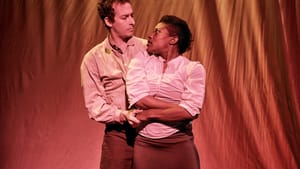Stay in the Loop
BSR publishes on a weekly schedule, with an email newsletter every Wednesday and Thursday morning. There’s no paywall, and subscribing is always free.
‘Underground Railroad Game’ plays on America’s racial narratives

At times, we may try to escape from reality by watching a fictional performance. Yet Underground Railroad Game, premiering in this year’s Curated Fringe Festival at Christ Church Neighborhood House on September 4th, walks a fine line between fiction and reality. Show creators Jenn Kidwell and Scott Sheppard say it’s a dark satire about the racial underpinnings of the way we teach American history and the narrative of America, set as a game throughout the piece, in which the rules are constantly shifting onstage.
This duo has presented Underground Railroad Game as an in-process piece in locations like New Orleans, New York City, and Rhode Island, but they’re excited for its full-length premiere in the 2015 Fringe. Now with more resources, the creators can truly make the complexities of the story come alive onstage, with captivating props.
Middle-school inspiration
Kidwell and Sheppard originally met through the Pig Iron School for Advanced Performance Training. They discovered how different their styles were and how they’d be the perfect mix for future collaborations. For example, Sheppard’s strengths lie in looking at the entirety of a piece in relation to causality and narrative, but Kidwell thinks more in terms of episodes and events.
The inspirations for this piece include Sheppard’s experience as a student in south central Pennsylvania, where reenactment culture and romanticism of the Civil War prevailed. When he was in 5th grade, the thematic unit for the year was the Civil War. One day, the teachers introduced the Underground Railroad Game, a live-action game in which Confederate and Union soldiers fought against each other, with African-American rag dolls in safe boxes placed in each classroom. Sheppard said it was a problematic method of teaching.
“This was the seed for this dark satirical piece about American pedagogy and the way in which we look at race in American schools. Specifically about the Underground Railroad and the Civil War, but also how the effects of history continue to infect the present.”
Kidwell added that the inspiration for this piece is emblematic of how we are dealing with each other today. Although it’s about two teachers specifically, it explodes into a social critique of a lot more than that, according to Sheppard.
Stereotypes for a cause
As racism has caught the attention of the media, the show’s creators hope to dial up the conversation. Exaggerating stereotypes, they want to offer a new understanding of racial issues. Sheppard and Kidwell attack two tropes head-on: the “Magical Negro” and the “White Savior,” highlighting the oversimplified traits of these characters often found in mainstream movies and theater.
“Our goal is to turn that on its head and take down the people who make the rules,” said Sheppard.
“I keep hearing people say, ‘It’s not like theater’s gonna change the world.’ But I do think there’s something to be said about trying to switch up the conversation a bit. I think we’re trying to look at the rules for what they are, and our relationship to these parameters,” said Kidwell.
“We’re always told how we’re supposed to respond to things. And we’re trying not to do that,” she added. So the audience is allowed to draw its own conclusions. Although not a show for children, Underground Railroad Game highlights issues that individuals might not know how to address, but are imperative for society to tackle.
Underground Railroad Game ($15-$29) is coming to Christ Church Neighborhood House, 20 N. American Street, Philadelphia, from September 2-12 (opening on September 4).
Sign up for our newsletter
All of the week's new articles, all in one place. Sign up for the free weekly BSR newsletters, and don't miss a conversation.

 Melissa Skolnick-Noguera
Melissa Skolnick-Noguera